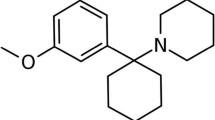Abstract
We report a case of a 6-year-old boy who had been living with his parents, both cocaine smokers, and who was urgently admitted to hospital for general distress. Upon examination, cocaine and cocaine metabolites were detected in hair and urine samples. These toxicological findings most likely indicate that the child had passively consumed the drug when living in a heavily contaminated environment.
Similar content being viewed by others
References
Cone E, Darwin W, Wang W (1993) The occurrence of cocaine, heroin and metabolites in hair of drug abusers. Forensic Sci Int 63:55–68
Skender L, Karacic V, Brcic I, Bagaric A (2002) Quantitative determination of amphetamines, cocaine, and opiates in human hair by gas chromatography/mass spectrometry. Forensic Sci Int 125:120–126
Cirimele V, Kintz P, Doray S, Ludes B (2002) Determination of chronic abuse of the anaesthetic agents midazolam and propofol as demonstrated by hair analysis. Int J Legal Med 116:54–57
Ursitti F, Klein J, Sellers E, Koren G (2001) Use of hair analysis for confirmation of self-reported cocaine use in users with negative urine tests. Clin Toxicol 39:361–366
Strano-Rossi S, Offidani C, Chiarotti M (1998) Application of hair analysis to document coercive heroin administration to a child. J Anal Toxicol 22:75–77
Lewis D, Moore C, Morrissey P, Leikin J (1997) Determination of drug exposure using hair: application to child protective cases. Forensic Sci Int 84:123–128
Wennig R (2000) Potential problems with the interpretation of hair analysis results. Forensic Sci Int 107:5–12
Pötsch L, Emmerich P, Skopp G (2002) Preliminary approach to elucidate the role of pigment as a binding site for drugs and chemicals in anagen hair: differential uptake of 3H-haloperidol by pigment-producing compared to non-pigment-producing cell lines. Int J Legal Med 116:58–61
Pötsch L, Emmerich P, Skopp G (2002) Preliminary approach to elucidate the role of pigment as a binding site for drugs and chemicals in anagen hairs: pigments as carriers for 3H-haloperidol in HaCaT/Sk-Mel-1 co-cultures. Int J Legal Med 116:12–16
Schaffer MI, Wang WL, Irving J (2002) An evaluation of two wash procedures for the differentiation of external contamination versus ingestion in the analysis of human hair samples for cocaine. J Anal Toxicol 26:485–488
Smith FP, Kidwell DA (1996) Cocaine in hair, saliva, skin swabs, and urine of cocaine users’ children. Forensic Sci Int 83:179–189
Mieczkowsky T (1997) Distinguishing passive contamination from active cocaine consumption: assessing the occupational exposure of narcotics officers to cocaine. Forensic Sci Int 84:87–111
Romano G, Barbera N, Lombardo I (2001) Hair testing for drugs of abuse: evaluation of external cocaine contamination and risk of false positives. Forensic Sci Int 123:119–129
Koren G, Klein J, Forman R, Graham K (1992) Hair analysis of cocaine: differentiation between systemic exposure and external contamination. J Clin Pharmacol 32:671–675
Chiarotti M, Strano Rossi S (1996) Preparation of hair samples for drug analysis. Forensic Sci Rev 8:112–128
Society of Hair Testing (1997) Forensic Sci Int 84:3–6
Chiarotti M, Strano Rossi S (1999) La ricerca delle sostanze d’abuso in campioni di capelli. In: Giusti G (ed) Trattato di Medicina Legale e Scienze affini, vol. IV. CEDAM, Padova, pp 119–143
Author information
Authors and Affiliations
Corresponding author
Rights and permissions
About this article
Cite this article
De Giorgio, F., Strano Rossi, S., Rainio, J. et al. Cocaine found in a child’s hair due to environmental exposure?. Int J Legal Med 118, 310–312 (2004). https://doi.org/10.1007/s00414-004-0470-3
Received:
Accepted:
Published:
Issue Date:
DOI: https://doi.org/10.1007/s00414-004-0470-3




